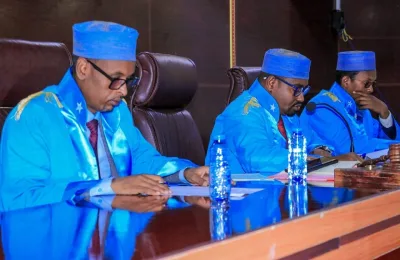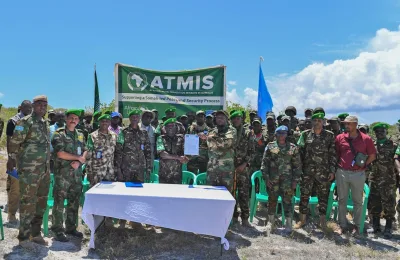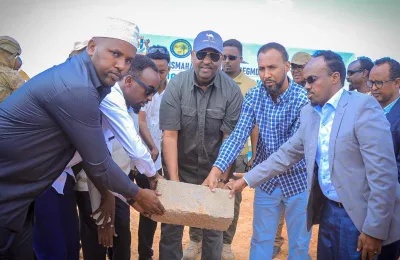Somalia: The structure of the Somali economy is therefore very much in transition, though low levels of foreign direct investment, lack of specialization and limited diversification all affect both economic and social outcomes.

Somalia stands at a crossroads
Down one road the current economic status quo will prevail, leading to anemic growth, high levels of informality (90%), unemployment (47 percent, 75 per cent for the youth) and lack of diversification and specialization. Down the other road, a new economic policy and investment framework could accelerate economic growth and employment, allowing Somalia to capitalize on its unique strategic position and undoubted natural and human resources potential.
I have been working in Somalia since 1993, and happened to be in Mogadishu the day the Black Hawk was shot down by Mohamed Farrah Aidid’s militia. Sitting in Mogadishu at the time, following the collapse of Siad Barre’s government in 1991, it was clear that history had been very unkind to Somalia since the so-called Golden Days of the Land of Punt. In that period, Somalia was a significant trade partner with Egypt, plying lucrative trade routes connecting with merchant classes from Parthian Persia to Phoenicia, and from Ptolemic Egypt to Greece and the Roman Empire.
Since 1993, the citizens of Somalia have struggled to re-establish the core functions of an effective state, though in recent years substantial progress has been made. International cooperation partners have re-balanced external support to balance structural development finance with humanitarian support. With Government revenue’s now rising year-on-year, the next decade will be absolutely critical to changing the course of history for the better.
This short article does not discuss macro-fiscal issues, which are important, but related to the real and wider economies.
Why is the Somali Economy Important?
Anyone who understands state-building knows that revenue collection is a pre-condition for any state, as it seeks to coopt the periphery and mobilize legitimacy through the provision of growth, employment and health enabling services. Once the social contract breaks down, as it did, citizens take up arms to defend themselves, precisely because the state has failed to do so.
Building good governance and maintaining law and order costs money! As it is difficult to tax the informal and illegal economies, the Government has few options but to control the formal economy, or to catch airways flyover taxes of customs duties. While VAT and GSM taxes provide a solution for taxing the informal economy, tax administration requires considerable capacities; which in turn are related to the ability to mobilize resources. This is a vicious cycle, though well-targeted external aid can be deployed to build core revenue capacities, and this process has now started in earnest.
Without a strong formal economy or a taxable informal economy, Government will not have the fiscal resources necessary to deliver public goods; including building trade and value chain infrastructure. As a result, all efforts must be linked to maximizing investment returns to growth, revenues and jobs.
What is the current Structure of the Somalia Economy?
The Somalia economy has still not been well documented, through recent research undertaken by Hayaan Institute for Research and Policy, USAID and the World Bank provides considerable insight into the current structure of Gross Domestic Product (GDP). The International Monetary Fund (IMF) and the World Bank estimate Somalia’s GDP at about US$5.7 billion in current dollar terms in 2014, though given the scarcity of hard economic data and porous borders which undermines recordation of informal economy flows, the economy is likely to be 20-50% bigger than these estimates. Having lived in Afghanistan for many years, preparing the early economic updates with Bill Byrd, as the Government’s capacity to collect data increased, new markets and trade flows were finally documented.
In Somalia for example, there has traditionally been considerable illegal fishing, and as a result, the fishing maritime economy is likely to be very badly reflected in GDP; which of course does not include the illegal, combat or coping economies. So what is known of the current structure of GDP?
- Private Consumption and Imports: According to the World Bank 2015 Economic Update, ‘Household consumption, financed by remittances, was equivalent to more than 100 percent of Somalia’s nominal GDP in 2014, with food and beverages accounting for about 60 percent of the total.’ (World Bank, 2105). Net investments only accounted for 8% of GDP and exports 14%.
- Remittances: Given the size of the Somali Diaspora, remittances have been estimated anywhere from US$1.2 to US$2.0 billion, equivalent to 23–38 percent of GDP. Of course, the financial crisis in 2008 and 2009 affected remittances considerably, and as a result, global economic conditions considerably determine the value of remittances to GDP. Evidence from the2013 Somaliland Household Survey shows that 31 percent of urban households and 16 percent of rural households received remittances (World Bank, 2015)
- Livestock: The entire world knows that livestock is the backbone of the Somali rural economy; and it represents the largest sector. Export data collected by the FAO-managed Food Security and Nutrition Analysis Unit (FSNAU shows that in 2014 some 5 million livestock were exported to the Gulf States. This included 4.6 million goats and sheep, 340,000 cattle and 77,000; valued conservatively at around US$360 million.
- Agriculture and fisheries: While Somalia is often thought about at largely drought-ridden and dependent on rain-fed agriculture and flood recession agriculture, the reality is that the size and potential of the agricultural sector is largely unknown, and often poorly documented. Similarly, with the collapse of the Somali Coast Guard the extremely high level of illegal fishing not only deprives the economy and communities of wealth creation, it also deprives the government of important revenues. Modest investment in modernizing local fishing, including establishment of cold storage chains and SPS certification, would yield considerable wealth creation.
- Financial Markets: The Central Bank recognizes only 50 financial institutions operating in Somalia, and in addition to handling remittances, trade finance is also provided, the commercial banking sector is transitioning from an un-regulated sector to one that is fully in line with the 2012 Financial Institutions Act. Traditional money transfer businesses are in decline. Lowering the costs of finance and increase access are critical to spurn the emergence of a dynamic small to medium enterprise sector, and to smooth household consumption.
- Telecommunications and Media: In recent years telecommunications have taken off considerably, and this has been linked to money payments also. The expansion of the sector – which now includes over 20 companies – also provides opportunities for taxing users – as Afghanistan has just done; to broaden the tax base. TV, radio, newspapers and online news are all expanding rapidly. Law Firm Hogan Lovells reported the following characteristics:
- Somalia has the lowest international call rates in Africa and one of the cheapest in the world (CIA World factbook, 2012);
- 2.34% of adults in Somalia use mobile money (World Bank, 2012) though this will have increased substantially;
- US$1.6 billion in money remittances were handled annually (CIA World factbook, 2012), though again this is assumed to have increased;
- Somali’s online Dahabshiil is one of the largest money transfer companies in Africa, operating in 155 countries (The Guardian, July 2012)
- Imports: Without an industrial base Somalia remains heavily dependent on imports. Again, according to the World Bank, trading partner countries show that imports reached $3.3 billion in 2013 and are projected to reach $3.7 billion in 2015. Support for import substitution in key areas of the economy will not only improve the balance of trade (Somalia ran a trade deficit of 39% in 2012), it will also boost the local economy and create employment at home. Options for this are discussed below.
- Precious Stones and Minerals: Somalia also has not inconsiderable mineral deposits, among which precious and semi precious stones and oil and gas are known. With international commodity prices currently in free fall, and with significant divestiture underway in relation to oil, it would be decades (if at all) that oil deposits will be tapped. The size of the precious and semi-precious stone economy is unknown.
- Other: Somalia is traditionally known for both Frankincense and Myrrh, among other gums and spices, and though these markets are small, they are growing. If well managed, latent potential can be exploited, though sustainability must been heavily considered. In addition, Somalia also exports charcoal, bananas, sugar, sorghum and corn among other items. Khat is also widely traded, and has allowed considerable fixed capital contributions to the economy to be made, as Opium has also done in parts of Afghanistan. An estimated 10 million people globally consume Khat, of which Somalia is a considerable supplier. Airlines are a growth driver also, though market distortions also exist.
The structure of the Somali economy is therefore very much in transition, though low levels of foreign direct investment, lack of specialization and limited diversification all affect both economic and social outcomes. That said, coming from an extremely low base, and with a high intellectual Somalia Diaspora increasingly looking to play a greater role in Somalia’s future, the next 10-20 years could be historic, if the right investment framework is established, and enabling systems put in place.
What is the preferred economic policy and investment strategy?
I am a former government economist, but since 2008, but I also the owner of multiple businesses. As a result, any economic growth policy must balance public and private capabilities, and it must work in a targeted and systematic way to establish business models that can be replicated and scaled. Moreover, the private sector is generally more concerned about balancing risks and rewards and operating in an economy where the legal framework protects investors. Foreign companies will only look for sweetheart deals here, unless they can invest long term within an enabling framework.
Outside of domestic consumption, Somalia has always had a fairly traditional economy, reflective of largely un-processed primary products and low value added processes. The structure of the economy directly reflects rational risk seeking behavior and the results of weak state regulatory capacities, and as a result the future of the Somali economy must be considered rather bright. Moreover, as times change and functional restructuring of state authorities progresses, the chances of political settlement sooner rather than later might for once be on the cards; though support from AMISOM will be critical over the longer term.
A critical observation here related to what is referred to as the ‘triple transition’. This means, that security and law and order are only possible once political settlement has been reached, and full economic development is only possible once security and rule of law are established. However, it is clear, that if the entire population of Somalia is sufficiently vested in the formal and informal legal economy, the chances of peace and stability increase massively. Resource scarcity and competition are drivers of instability and predation.
In the future it is important to create and foster mutual dependencies between sectors and with the wider region, though increasing access to power and financial markets will be key drivers in the value addition transition. On the economic side, this means establishing an evidence-based economic policy and investment framework, to include both traditional and un-traditional models of investment financing. One of the many lessons we have learned in countries from Egypt to Afghanistan and from Ethiopia to the United Arab Emirates is to identify a financing modal and modalities that work well even in a difficult context.
Read Full article – Download here
—-
Dr. Peter J. Middlebrook is a former UK Government, European Union and World Bank Economist and CEO of Geopolicity Inc, an international management consultancy group based on the UAE. He leads
much of the economic work on Regional Cooperation and the New Silk Road in Central Asia and was lead economist on the proposed Arab Stabilization Plan.







